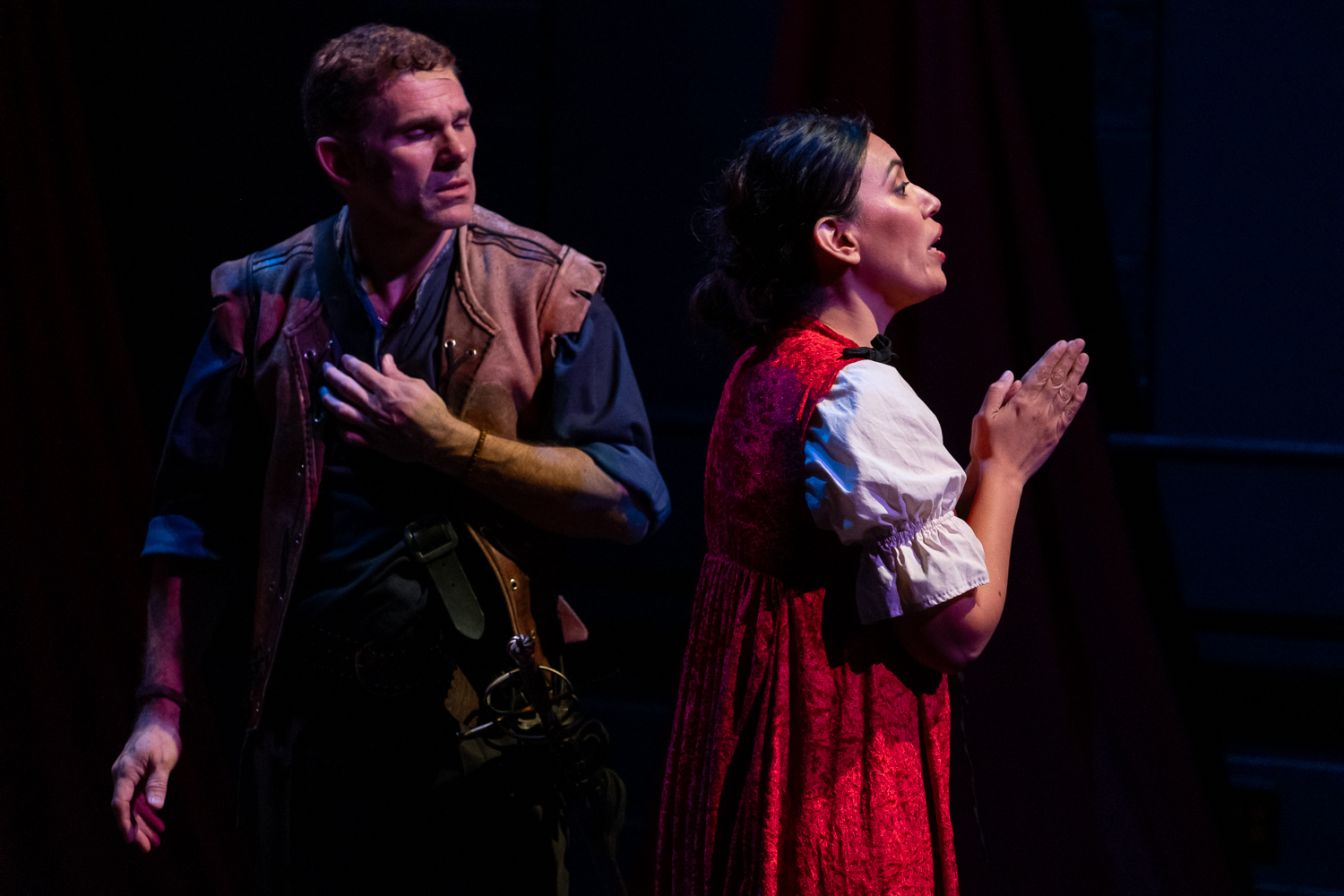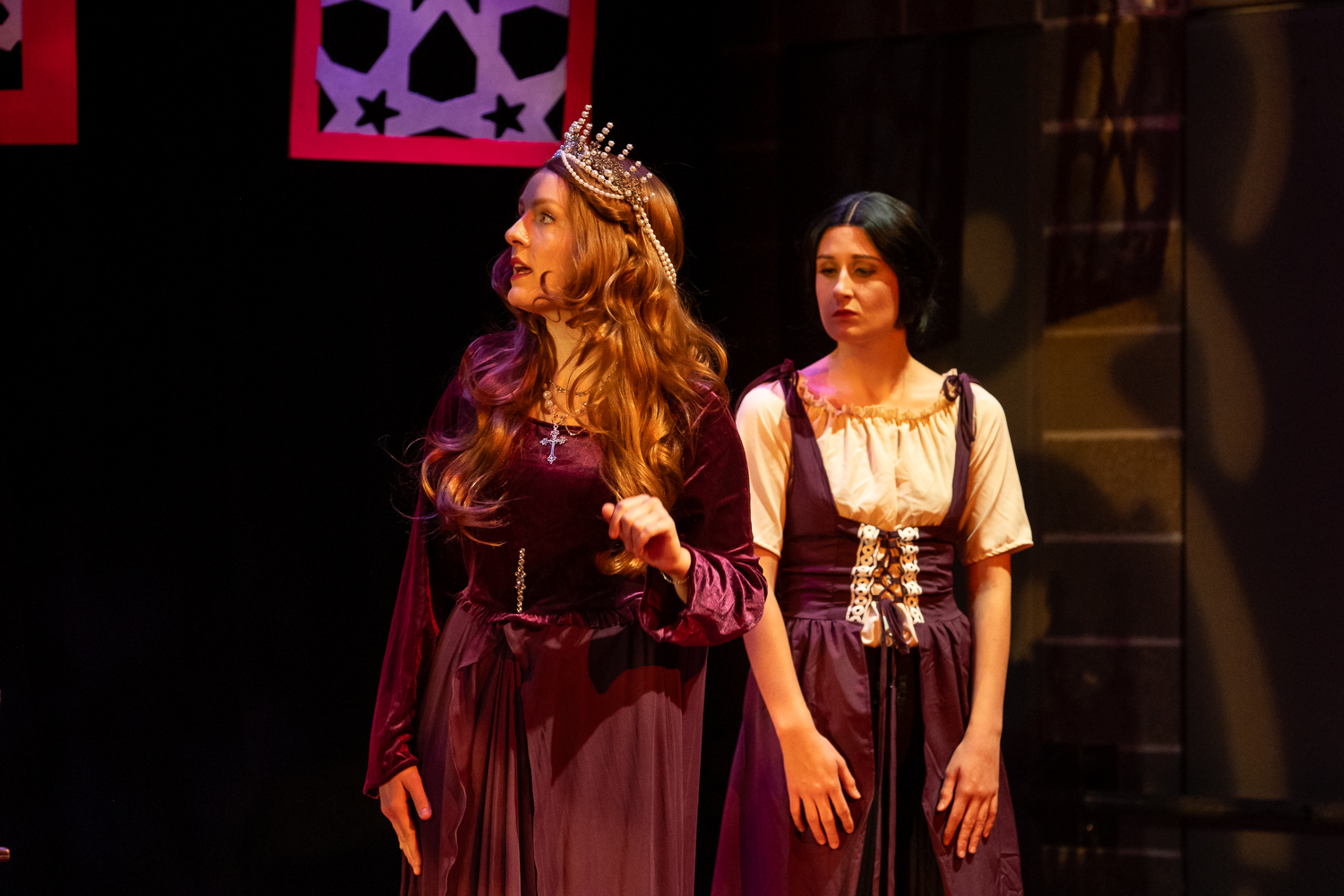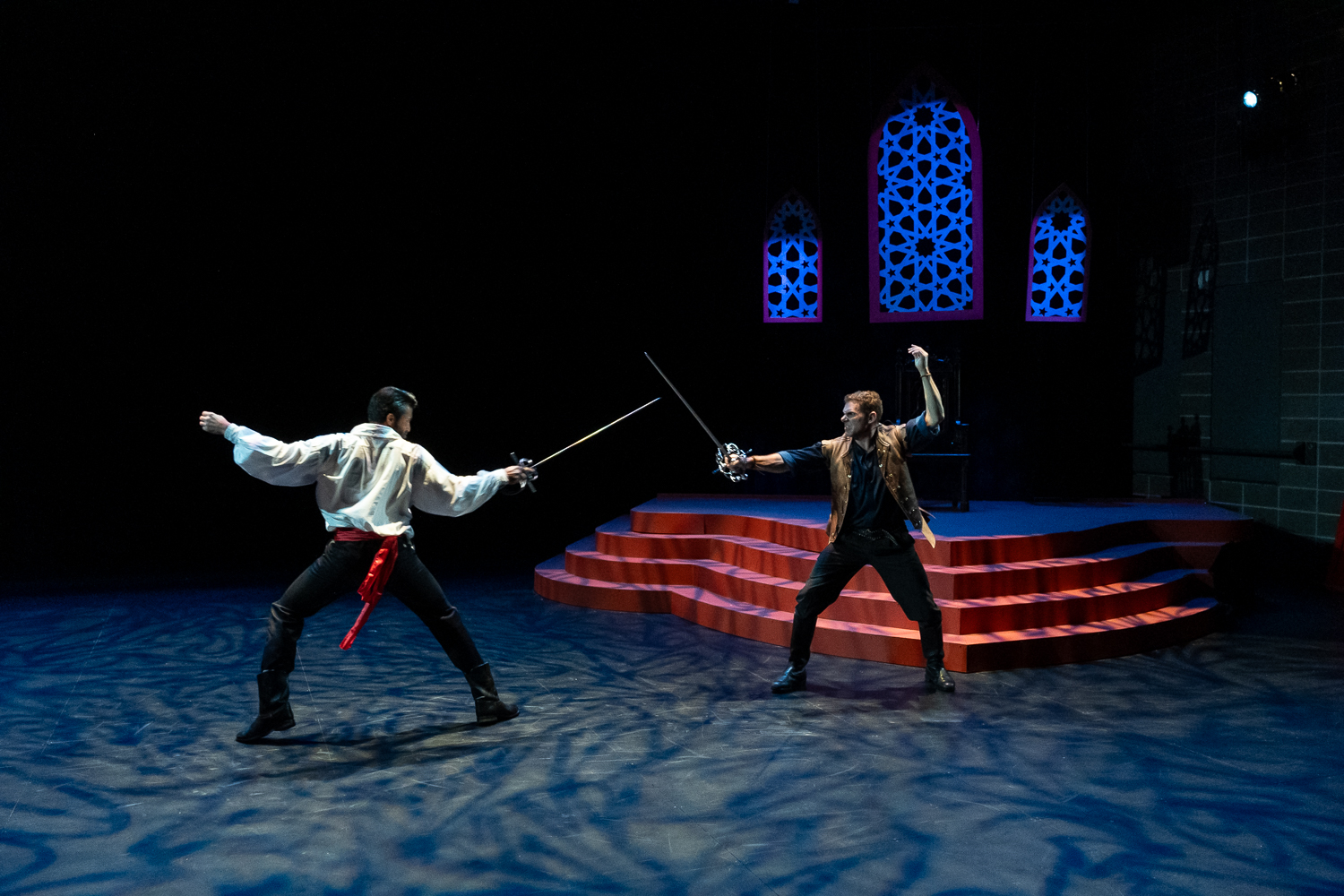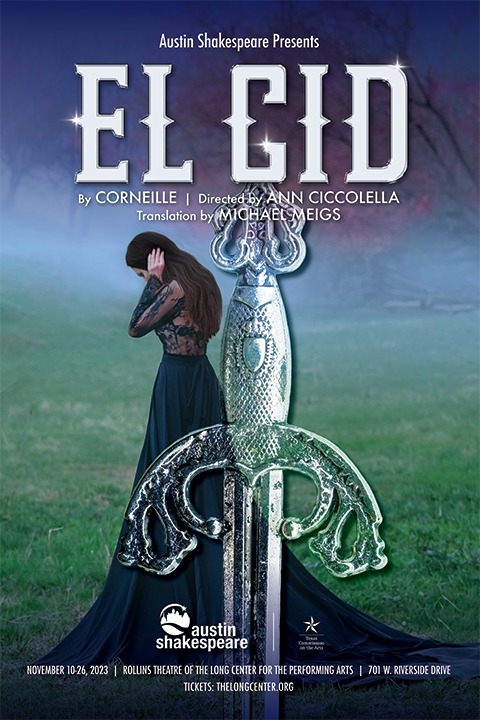Review: El Cid by Austin Shakespeare, November 10 - 26, 2023
by David Glen Robinson
Austin Shakespeare has just premiered a new translation of Pierre Corneille’s Le Cid at the Rollins Studio Theatre at the Long Center. Its lengthy production period heightened the theatre community’s anticipation. Austin Shakespeare’s El Cid gives us a certain innovation in language. The play, written in French, premiered in Paris in 1636. This modern translation is a bilingual English/Spanish version. The translation is by Michael Meigs, who has long advocated for more balanced contributions by the language participants in bilingual productions. Indeed, the play seemed to have a 50 per cent contribution by each language. [Ed. note: 16% of the script is in Spanish.] The work was highly successful in terms of audience comprehension of the dialogues and ability to follow the rather convoluted story lines. Kudos to artistic director Ann Ciccolella for suggesting the innovative concept and to translator Meigs who did the heavy lifting to build word images in two languages.
The play is old but not well known. In Ciccolella’s director’s notes: “Today we bring you a rarely staged heroic romance from the 17th Century—new territory for us.” Old, but new in innovation as mentioned. The story is definitely ancient, and it elaborates the ancient trope of lovers held apart by misunderstanding, deception, and/or honor. El Cid centers on the historical figure of Rodrigo Diaz de Vivar, a commoner sellsword or sword for hire, a mercentary without loyalties available to fight and kill for money from whoever would pay. He rose to command of the armies of Castile and led the Reconquista of Spain from the Moors. The Cid died laden with honor.
Corneille adds onto his story a deep romantic love for Ximène or Ximèna (Shih-MAYN, approximating Corneille's French pronunciation), daughter of don Gormès, a noble of the court of the king of Castile. A twisted and knotted plot line follows from this point. Austin Shakespeare brings their version to completion in two and a half hours, includiing the fifteen-minute intermission.
The company's El Cid, with its cloud-raking declamations of honor, blood, lineality, and death, is a downwind production of what by consensus is Corneille’s greatest work. This production is marked by a spareness that runs through the set and all the design fields. This quality, which often successfully backgrounds the dramatic peaks of a performance, in El Cid seems to level out all dramatic high points created by the hardworking actors. It is not what anyone would call a lavish production.
The minimalistic set design illustrates the dynamic. Diagonals sweep the entire wide black-box playing space of the Rollins. A raised royal throne room commands the upstage left corner, arcing toward the downstage right. The front downstage right corner is used for smaller, quieter scenes that set forth important plot points. Upstagee right corner contains only an entrance/exit point through a high Moorish arch. Elsewhere, large expanses of stage floor remain bare for sometimes overcostumed actors to enter to find their light and deliver monologues and dialogues.
The exact upstage left corner behind the throne offers a raised, cutout set of windows to light the royal court. The fake court windows lacked backlighting to project light into the court hall and thereby enrich the court scenes. That also would have greatly strengthened the “pools of light” concept in which settings for scenes are changed simply by changes in focal lighting. Set and lighting designer Patrick Anthony addressed the design challenges, coming into the production from two recent community productions.
The large cast featured several newcomers to Austin Shakespeare, some perhaps cast especially for their bilingual abilities. Several were impressive standouts, but overall there was some some unevenness of physicality, vocal skill, and in one case almost no ability to project.

Veronica Kraemer as Ximène the lead principal was was the capable wheel horse of the show, leading everyone through the story. A diminutive figure, Kraemer at times seemed engulfed in the flowing robes of a court noblewoman. In the emotional peaks of her despair her voice rose to high-pitched complaints more appropriate to a high-school soccer field than to the court of Castile. Her lover Rodrigo, played by Sebastian Vitale, commanded the stage in all aspects, his stage presence assuring the audience that he would someday become the military commander of Castile. The contrasts between Vitale and Kraemer left the couple with hardly any romantic chemistry between them.

The frustrated royal princess (Infanta) was played by Eliza Renner, attired throughout in a floor-length purple gown, spectacularly paired with flowing red hair surmounted by a bedazzled crown larger than her father’s. The crown had pearl strands looping down almost to the princess’s shoulders. Going over the top created a costuming fail, Her crown and styling made for great, swaggering seventeenth-century royalty drag and may someday fit well into an animé El Cid. The imagery overwhelmed her skilled, sensitive presentations. Costume, hair and makeup design are credited to Cecelia Gay.
Senior nobles turned in lapidary work. They are Pablo Muñoz-Evers as don Sánchez, Nolan Muña as the count don Gormès, Joaquin Gonzalez as don Arias, Joseph Paz as don Alonso, and Ev Lunning as don Diego, Rodrigo’s father. Veteran actor Lunning has a powerful, clear bass voice with a sharpness that seems to fire from the teeth instead of farther back (he uses his nasal passages well, too). His is a Stratocaster of a voice. Kudos to Ev Lunning. Rupert Reyes as King Fernando gave an understated performance, clear and with great confidence, conveying subliminally to the audience I’ve got this king thing down—it’s all in the wrist, you know.
Vanessa Alvarado Flores and Darby Williams performed their court supporting roles well. Bennie Braswell as the violin-playing page announcing the acts played only a few notes each time. She probably needed more music to capture the attention of the chatting audience. The cast performed a lot of hard work, and it did not look easy, but they did well on a spare stage. A few dropped lines and overlong pauses on opening night were imminently forgivable and correctable. A little training and review on how to pick up and move on is always refreshing.

One feature of the performance that merits strong praise is the super-good sword fight between Rodrigo and the count, performed by Sebastian Vitale and Nolan Muña. The fight not only pivoted the plot, but it also determined the plot. It slashed across stage long enough to raise the emotions of the audience to a peak. Kudos to the skilled actor-swordsmen, to fight choreographer Tobie Minor, and to fight captain/production stage manager Luisa Ann Torres . The clash of edged weapons hasn’t been this dramatic since Archive Theatre’s Cyrano de Bergerac, followed by their Macbeth.
The importance of swordfighting has diminished since Corneille’s seventeenth century. That century’s swords in infantry masses held geopolitical significance, the equivalent in our day to surface-to-surface rockets and their interceptors. The El Cid fight offered great swinging style, flourishes of honor and contempt, and risky moves to demonstrate skilled superiority. Think Three Musketeers (not the candy bar). Therein lies a possible issue. El Cid is a tale about lthe late middle ages, 500 years before Corneille's times. Medieval warriors didn’t fight like Rodrigo and Don Gormès. Medieval stalwarts fought with single-edge saber-type and double-edged dagger-type chunks of steel fit for caving in metal helmets; honor, troubadours, and romanticism were anachronistic, unknown concepts. But rather than being an error, this suggests that Corneille was looking at the eleventh century through the lens of the seventeenth; his point of view allowed for social commentary upon his day while providing deniability. The same practice is becoming a trend today in twenty-first century theatre, though with far less success.
The essential messages of the play came through the obvious hard work performed by the entire cast and production team. Corneille’s play and others in that class of French plays turned a kind of corner on Greek tragedy by doubling their characters’ dilemmas. Resorting again to the director’s notes:
“For Corneille, honor means more than superficial duty; it is the moral commitment to live by what is right. At the play’s outset, the external conflict arises between each of the lover’s fathers, but as the story progresses each of the lovers faces their own serious moral dilemma. This type of moral knot made Corneille world-famous for the ‘Cornellian dilemma,’ i.e., when a character believes he should do two opposing moral actions and must decide on one. That passionate conflict is at the heart of El Cid.”
El Cid plays until November 26th, 2023, at the Long Center, central Austin. Lovers of historical dramas will want to add this one to their collection.
EXTRAS
Click to view Austin Shakespeare's program for El Cid, translated by Michael Meigs
or use your phone and this QR code to view the full-color version:

Review by Shannon Gibson, Bat City Stage Reviews, November 18, 2023
El Cid
by Pierre Corneille, translated and adapted by Michael Meigs
Austin Shakespeare
November 10 - November 26, 2023
NOVEMBER 10 - 26, 2023
THE ROLLINS THEATER AT THE LONG CENTER FOR THE PERFORMING ARTS
Tickets, which start at $20, are available here.
For student discounts with valid ID (less than $20) or discounts Group discounts for 10 or more people, please call the Long Center's 3M Box Office at: 512.474.LONG (5664) (M-F 10am-5pm CT) or email boxoffice@thelongcenter.org.
